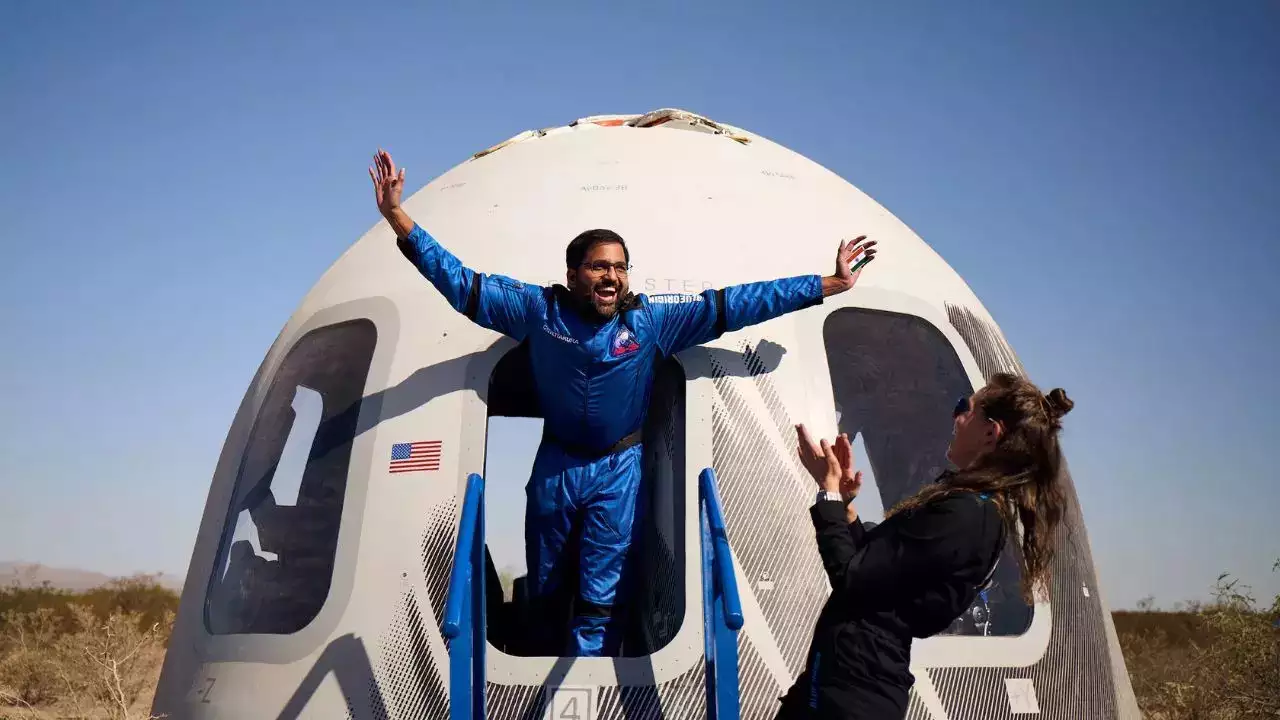Gopi Thotakura made headlines on Sunday by becoming the first Indian to travel into space as a tourist on Blue Origin’s NS-25 mission. This event marked a proud moment for both Thotakura and India, as he became the second Indian to venture into space after Wing Commander Rakesh Sharma’s historic flight in 1984.
here
An Adventurous Spirit – Gopi Thotakura
Born in Vijayawada, Andhra Pradesh, Gopi Thotakura is not just an entrepreneur but also an accomplished pilot with a passion for adventure. He joined a diverse crew on this mission, including notable figures like Ed Dwight, who was the first Black astronaut candidate selected by President John F. Kennedy in 1961. Although Dwight never flew to space during his initial training years, this mission finally gave him the opportunity.
Thotakura’s journey is a source of immense pride for India. Despite living in the United States, he retained his Indian citizenship, making his flight a significant event in India’s space history.
A Diverse Career in Aviation
Thotakura’s career in aviation is remarkable. He co-founded Preserve Life Corp, a wellness and health center near Atlanta’s Hartsfield-Jackson International Airport. His flying experience is vast, including commercial jets, bush planes, aerobatic and seaplanes, gliders, and hot air balloons. He has also served as an international medical jet pilot. His adventurous nature is evident from his recent climb of Mount Kilimanjaro, which adds to his impressive list of accomplishments.
The Historic NS-25 Mission
The NS-25 mission is a major milestone for Blue Origin’s New Shepard program. The fully reusable sub-orbital launch vehicle, designed for space tourism, took off from West Texas and successfully carried six astronauts past the Kármán line, the boundary of outer space. The rocket booster landed safely minutes after takeoff, and the capsule touched down gently using two of its three parachutes.
During the flight, the crew experienced the thrill of weightlessness and enjoyed breathtaking views of Earth. This mission was the 25th in New Shepard’s history and the seventh to carry humans, bringing the total number of people flown by the program to 37.

Environmental and Educational Impact – Gopi Thotakura
Blue Origin emphasizes sustainability, with nearly 99% of the New Shepard’s components being reusable. The vehicle runs on liquid oxygen and hydrogen, producing only water vapor and ensuring zero carbon emissions.
In addition to its environmental efforts, Blue Origin’s foundation, Club for the Future, aims to inspire future generations. Each astronaut carried a postcard to space, part of an initiative that allows students to send postcards to space and back. The foundation’s goal is to encourage young people to pursue careers in science, technology, engineering, arts, and mathematics (STEAM).
Personal Reflections and Family Pride – Gopi Thotakura
During the flight, Thotakura proudly represented India by holding a small Indian flag and a banner reading, “I am an eco-warrior for our sustainable planet.” His grandparents, Bhumaiah and Swarnalata, expressed immense pride in their grandson’s achievements. They fondly recalled his active and unique nature as a child, always eager to explore unconventional paths.
Thotakura’s family, including his parents Vijayakumar and Padmaja, and his brother Meghashyam, celebrated his achievement. His strong ties to Vijayawada, where his grandparents live, added a personal touch to this historic moment.
Educational and Professional Journey
Thotakura’s educational background is impressive. He completed his primary education in Visakhapatnam, Hyderabad, and Delhi, graduated from Sarla Birla College in Bengaluru, and earned a degree in aeronautical science from Embry-Riddle Aeronautical University in Florida. He also holds an MBA in Aviation from Coventry University in the UK. His extensive training and flying experience have prepared him well for such a pioneering journey.

Looking to the Future
Gopi Thotakura’s historic flight as the first Indian space tourist symbolizes the expanding possibilities in space tourism and underscores the importance of international cooperation and innovation in aerospace. His journey is not just a personal achievement but also an inspiration for future generations, encouraging them to dream big and explore the final frontier.
Advanced Programs and Impact
ISRO operates the world’s largest constellation of remote-sensing satellites and manages the GAGAN and IRNSS (NavIC) satellite navigation systems. It has launched three missions to the Moon and one to Mars. The organization’s work has significantly impacted India’s socio-economic development, aiding in disaster management, telemedicine, navigation, and reconnaissance. ISRO’s technological innovations have also contributed to advancements in India’s engineering and medical sectors.
Indian Space Research Organisation (ISRO): A Journey of Excellence
The Indian Space Research Organisation (ISRO) stands as a beacon of India’s achievements in space exploration. Operating under the Department of Space (DoS), ISRO’s efforts are overseen directly by the Prime Minister of India. The agency’s chairman also serves as the executive head of the DoS, highlighting the close connection between ISRO’s work and the country’s top leadership.
Mission and Responsibilities
ISRO is dedicated to a variety of space-related tasks, including space-based operations, exploration, and international cooperation. It also focuses on developing cutting-edge space technologies. ISRO is among an elite group of six government space agencies worldwide with full launch capabilities, including deploying cryogenic engines and conducting extraterrestrial missions. It also operates an extensive network of artificial satellites and has mastered unmanned soft landing techniques.
Origins and Growth
ISRO’s roots go back to 1962 when it was established as the Indian National Committee for Space Research (INCOSPAR) by Jawaharlal Nehru, inspired by Dr. Vikram Sarabhai. It was renamed ISRO in 1969, still under the Department of Atomic Energy (DAE). In 1972, the government formed the Space Commission and the DoS, bringing ISRO into its fold and formalizing India’s space research efforts.
Notable Achievements
ISRO launched India’s first satellite, Aryabhata, in 1975 with the help of the Soviet space agency Interkosmos. By 1980, India had launched the RS-1 satellite aboard the SLV-3, making it the seventh country capable of orbital launches. This was followed by the development of the ASLV and a series of medium-lift launch vehicles, rocket engines, and satellite systems, allowing ISRO to launch hundreds of satellites and conduct deep space missions.
Historical Foundations
India’s journey into space began in the 1920s with S. K. Mitra’s experiments on the ionosphere using ground-based radio in Kolkata. The contributions of scientists like C.V. Raman and Meghnad Saha laid the groundwork for space sciences. After 1945, coordinated space research took a leap forward thanks to Vikram Sarabhai, who founded the Physical Research Laboratory in Ahmedabad, and Homi Bhabha, who established the Tata Institute of Fundamental Research in 1945.
Early Endeavors
Early Indian space research included studying cosmic radiation, high-altitude testing, airborne experiments, and deep underground studies at the Kolar mines. These efforts were conducted at various research laboratories, universities, and independent institutions across the country.
ISRO’s story is not just about technological milestones but also about the vision and determination of countless individuals who have contributed to India’s presence in space. From its humble beginnings to its current status as a global space power, ISRO continues to inspire with its commitment to innovation, exploration, and the betterment of humanity.

